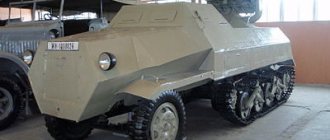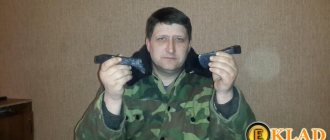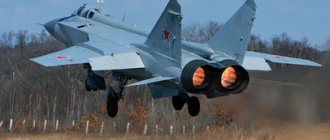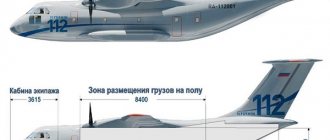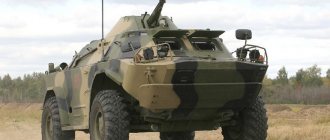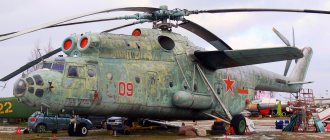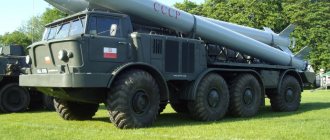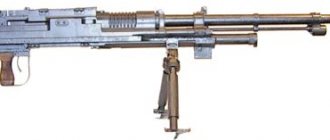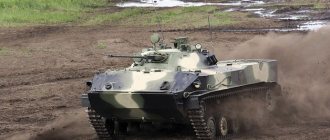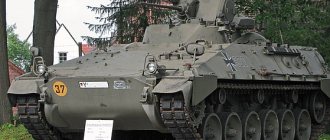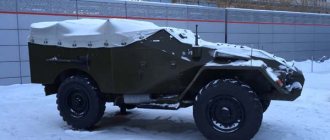BMP-1 (from Combat Mashina Infantry) is the first Soviet serial combat armored amphibious tracked vehicle, designed to transport personnel to the front line, increase their mobility, armament and security on the battlefield and joint actions with tanks in battle. It was developed at GSKB-2 (main special design bureau 2) at the Chelyabinsk Tractor Plant named after. V.I. Lenin to replace the BTR-50P.
Description of design
The crew of the vehicle consists of three people - a driver, an operator-gunner and a commander. The vehicle also carries a landing force of 7 people, who can fire through special embrasures from personal weapons.
Armored hull and turret
The hull and turret of the BMP-2 are welded from rolled steel armor plates with a thickness of 5 to 19 mm. The turret forehead is 23 mm thick.
In the left front part of the car there is a control compartment, in which there is a place for the driver with controls for the movement of the car, surveillance devices and a communications device. Behind the driver is the gunner's seat, equipped with an embrasure for firing personal weapons, as well as surveillance devices and communications equipment.
The engine and transmission compartment is located in the right front part of the machine, along the length of the machine it is combined with the control compartment and separated from it by a heat and sound insulating partition. For access to MTO units, there are hatches in the partition.
In the middle part of the vehicle there is a fighting compartment, which occupies the turret and the turret space of the hull. The fighting compartment contains the workstations of the operator-gunner and commander, as well as the main and auxiliary weapons. In the turret space there is a rotating floor in which boxes with machine gun cartridges are mounted, as well as a belt feeding system for the gun with armor-piercing tracer and fragmentation rounds. On the right side of the hull there are three stacks with ATGM rounds, another is located in the turret space.
The fighting compartment is located in the middle part of the vehicle. It occupies the tower and turret space in the hull. It houses the main and auxiliary weapons and their systems, as well as workstations for the commander (right) and operator-gunner (left). Mounted on the rotating floor are magazines with machine gun cartridges and a system that provides belt feeding of the gun with armor-piercing tracer and high-explosive fragmentation rounds. ATGM racks are installed in the turret space (one) and on the right side of the hull (three).
In the troop compartment, located at the rear of the vehicle, there are 6 workstations for shooters. Each has an embrasure for firing from personal weapons. In the stern there are two doors for the landing. The left door has an embrasure for firing from a machine gun. Also, for dismounting troops when moving afloat or emergency evacuation, there are two hatches above the seats in the hull roof. The troop compartment is separated by a middle fuel tank and an electrical equipment container that contains batteries, a heater and other electrical units.
Armament
The main difference between the BMP-2 and the BMP-1 is the new weapon system. The reason for the replacement was the experience of using the BMP-1 weapons, which had difficulty coping with the task of hitting typical infantry targets, especially those with lying down or hidden enemy personnel. The fight against low-flying air targets and light armored personnel carriers was problematic, and due to the low power of ammunition, low accuracy and short range of the 2A28 cannon, the fight against tank targets was not effective.
The main armament of the BMP-2 is a 30-mm 2A42 automatic cannon with 500 rounds of ammunition. Coaxed with the cannon is a 7.62 PKT machine gun, which has 2,000 rounds of ammunition. In addition, to combat tanks, the BMP-2 has a 9K111 “Fagot” or 9K113 “Konkurs” ATGM with 4 rounds.
The vehicle was also equipped with 6 grenade launchers of the 902B “Tucha” smoke screen system for firing 81-mm smoke grenades.
Surveillance and communications equipment
The driver's seat is equipped with surveillance devices and an A-3 tank intercom. The shooter's position behind him is equipped with TNP-165A and TNPO-170A surveillance devices. For communication there is an A-3 TPU device.
At night, the driver carries out an inspection with a TVN-2 device (for the driver), which is installed immediately before leaving, instead of the front triplex. The range and viewing angles are not large (in complete darkness), therefore, the driver cannot see what is on the sides of the car; this is already the responsibility of the commander and gunner operator with a report via intercom. The equipment is included with the equipment, but is most often stored separately from the machine.
The commander and operator's workstations have observation and aiming devices. The commander's station is equipped with an R-123M radio station and an A-1 TPU apparatus. The operator has an A-2 TPU device for internal communication.
The gunners' workplaces in the troop compartment and the aft doors for dismounting are equipped with TNPO-170A devices for monitoring the terrain. For internal communications, the troop compartment uses A-3 and A-4 TPU devices. In the right door there is a radio station R-126.
For aiming, the gunner operator uses a combined sight (depending on the modification, either BPK-1-42 or BPK-2-42) with a 5.6-fold magnification during the day and 5-fold at night. To operate in active mode, an OU-5 illuminator is installed on the machine. In addition to the sight, the gunner has 3 periscope devices TNPO-170A with electrical heating, as well as 1 rear observation device TNPT-1. For the vehicle commander, two TNPO-170A and one TNPT-1 devices, a TKN-3B binocular viewing device and a 1PZ-3 day sight are installed for searching for air and ground targets and aiming weapons at them.
Engine and transmission
The machine has two blocks. The first block is power and combines the engine, planetary rotation mechanisms and gearbox. The second is a cooling and cleaning unit, which combines radiators for the cooling system, engine lubrication, ejector, air cleaner and transmission oil system.
The engine, gearbox and planetary turning mechanisms are combined into a power unit, and the radiators of the cooling system, engine lubrication system, transmission oil system, ejector and air cleaner are combined into a cooling and air cleaning unit. The latter is attached to the beams of the roof of the building.
The engine is a 6-cylinder 4-stroke uncompressor diesel UTD-20S1 liquid-cooled with direct injection. The maximum power is 210…221 kW. The total mass of the dry engine is about 700 kg.
The power unit is located conventionally in the first block (aka compartment), at the very front of the car under the “ribbed” one. It includes a transmission including a gearbox, steering components, and a clutch. All this, to one degree or another, can be repaired in the field, since there is direct access. The engine, which is conditionally located in the second block (compartment), to the right of the driver, is completely closed and without special equipment, access to it is practically impossible. The only path to the engine is blocked by an armored plate along with the ejector; directly above it and without serious lifting equipment it is not worth even trying to make repairs. However, the designers clearly thought through this situation; if something happens to the engine, it means the vehicle is not combat-ready and therefore requires major repairs, and this can only be properly carried out at a specialized place.
Engine repairs are impossible in principle through the bulkhead hatches, and access is only for routine maintenance. But they are especially used in the cold season, when the engine has already warmed up, and the temperature in the cabin is not yet higher than outside, although the command “get to the cars!” has already arrived. This is where they save the day, the driver and those sitting behind him receive the first portion of heat, then those sitting in the turret and only then the troop compartment, with the condition that they travel for a long time and the rear doors do not open often. It should be noted that in general this compartment does not have much time to warm up, since the hatches close when a comfortable temperature for the driver is reached. After this, heating occurs due to partitions and forced heated air into the cabin.
Chassis
The base is a chassis with a six-wheel chassis; the design and characteristics are similar to the BMP-1.
Despite the caterpillar drive, the car is quite fast and the speed of 65 km/h on the highway is clearly underestimated for stable control, and at extremely high speeds the car simply becomes uncontrollable, the track tracks and asphalt at this moment become similar to skates and ice.
On rough terrain or a dirt road (if not similar to an asphalt road) it is impossible to accelerate more than 40 km/h, only due to the design features of the car, the entire weight of the engine and transmission falls on the nose, therefore, on uneven surfaces the car begins to bite, which in itself slows down the movement . Driving like a snake, the only way not to lose the speed gained is when only one caterpillar hits a bump, while the other doesn’t yet, as if going around it.
The vehicles of the BMP series use a unique steering control, something between the steering wheel in an armored personnel carrier and the levers in tanks, this is the so-called “steering wheel” (among the crews they call it the rudder), consisting of only two horizontal handles. With the same freedom of rotation as the steering wheel, this allows you to control the car like a wheeled vehicle, with the only difference being that its angle of deflection has its own limitations. When you turn it to the side, there is a smooth, uniform redistribution of thrust on the tracks, this is what allows you to avoid jerking the car when turning, as usually happens with tracked vehicles, which ultimately has a detrimental effect on the rollers and tracks. After releasing it, the “steering wheel” itself returns to its original state. Consequently, force must be applied only when turning, and the horizontal position at this moment indicates that the car is moving in a straight line. Thanks to this design, the control of the car is greatly facilitated and maneuvers such as a snake at speed are smoother.
BMP-1 - video
The combat vehicle was adopted by the Soviet Army of the USSR Armed Forces in 1966. Serially produced from 1966 to 1979.
Subsequently, the drawings and other documentation were transferred to the Kurgan Machine-Building Plant, where the BMP-2 was subsequently produced.
Design
To successfully overcome water obstacles, the BMP-1 was equipped with hollow metal rollers that increase buoyancy. The vehicle did not have a water cannon, so to increase speed afloat, special grates were installed on the rear wings, above the tracks, to redirect the flow of water from the tracks not upward, but backward. And in front, the shape of the hull directed the flow of water downwards, which raised the nose of the car above the water.
The BMP-1 received a fundamentally new track design, in which the moving parts did not overlap each other, as in a tank, which increased the service life of the metal and rubber seals to 8000 km.
The propulsion system was created on the basis of the very successful 12-cylinder V-2 diesel engine, which was the base unit for many civilian and military products of ChTZ and GSKB-2. The head of the engine design bureau and the author of many inventions for the BMP-1 engine was V.D. Chudakov. The chief designer was P.P. Isakov.
BMP-1 ammunition layout
Device
The BMP-1's armament includes a 73-mm 2A28 "Grom" smoothbore gun, a 7.62-mm PKT coaxial machine gun and a 9M14M "Malyutka" ATGM; the 9K32 "Strela-2" anti-aircraft missile system is also attached and transported in the troop compartment.
The armored hull of the BMP-1 is welded, made of high-hardness rolled steel armor. In the upper frontal part there is a large hatch, closed with a folding ribbed armor plate made of aluminum alloy, providing access to the engine. Conical tower. To protect against penetrating radiation from a nuclear explosion, an anti-radiation lining is used.
Due to the small elevation angle of the barrel, the crews of the vehicles in Afghanistan themselves mounted the AGS-17 “Flame” on the turret, which improved the combat properties of the vehicle in mountain conditions.
Protection
The TTZ requirements provided for protection of the vehicle from 23-mm armor-piercing shells from forward firing directions at a range of 500 meters, and protection all around from 7.62-mm armor-piercing bullets at a range of 75 meters. The frontal armor sheets of the BMP-1 hull located at large angles of inclination can withstand damage from fragments of field artillery shells, armor-piercing bullets from small arms and large-caliber 12.7-mm machine guns, the latter in a 60-degree firing sector from zero range. In most cases, frontal armor is not penetrated by ammunition from the 20-mm Oerlikon KAD automatic cannon (formerly Hispano-Suiza HS-820) at ranges greater than 100 meters. Side, rear armor and the roof of the hull and turret provide protection for the vehicle from 7.62 mm small arms bullets from zero range and from light artillery shell fragments, but do not protect against 12.7 mm machine gun fire at close range, or from heavy shells fragments. Field tests, however, have shown that the aft doors, whose fuel tanks are filled with sand, can withstand fire from standard 12.7 mm bullets. During the fighting in Afghanistan and Chechnya, when firing from general purpose machine guns (PKT, M60) at short ranges of about 30-50 m, 7.62 mm armor-piercing bullets in some cases pierced the rear doors and hatch covers of the BMP-1.
BMP-1 in Syria, the side grilles and the circular grille around the turret are made according to the “standard” design
BMP-1 in Syria with 2 additional machine guns installed in a homemade open armored cabin
BMP-1 in Syria with one additional machine gun installed in a homemade open armored cabin, plus mesh screens welded on top, most likely for urban combat conditions, although their effectiveness against RPGs is questionable
Anti-aircraft gun based on BMP-1 in Syria with side screens
Syrian BMP-1 with stingrays and sandbags tied to the sides, as they say for lack of anything better
BMP-1 in Syria with side screens, quite neatly and competently made
Criticism
Over the long period of operation of the BMP-1 and BMP-2, new “threats” to the protection of the vehicle repeatedly appeared. So at the end of the 1970s, after NATO adopted new 20x139 mm ammunition for the Hispano-Suiza HS 820, Rheinmetall RH 202 and M 693 (F2) cannons with APDS - DM 63 armor-piercing sub-caliber projectiles ( Germany) and OPTSOC (France), the ground forces of these states have the opportunity to hit the BMP-1 in the frontal projection from ranges of 800-1000 m. Ammunition for the M242 Bushmaster gun of the main US M2 Bradley infantry fighting vehicle, adopted in 1982, was designed from calculating the damage to the armor protection of the BMP-1, ensuring armor penetration of 28 mm/60°/1500 m.
The experience of the Arab-Israeli war of 1973 and the USSR war in Afghanistan showed that the armored hull of the BMP-1 cannot withstand hits from 12.7 mm bullets into the side projection of the vehicle, and a hit from an RPG anti-tank grenade, as a rule, caused the vehicle to ignite with a subsequent explosion of ammunition. During the first Gulf War, the armor protection of the BMP-1 and BMP-2 vehicles turned out to be vulnerable to armor-piercing sub-caliber projectiles from 25 mm automatic guns. According to test data conducted in the USA, the armor of the BMP-1 and BMP-2 is damaged by the M791 armor-piercing sabot projectile (BPS with compartment) of the 25-mm M242 Bushmaster cannon at ranges of 1500-2000 m. However, any large-scale modernization of both vehicles (BMP-1 and BMP-2) have not been included in plans to increase their security over the past decades.
Destroyed Iraqi BMP-1s, Operation Desert Storm
Modifications
Soviet
BMP-2 with AGS-17 "Flame"
The BMP-2 modification differs from the base vehicle in the presence of the AG-17 “Plamya” grenade launcher. The grenade launcher is mounted at the rear of the turret. Guidance is carried out remotely by the operator-gunner or commander. The ammunition is in a box with a tape for 250 shots. Produced in the USSR in a small series.
BMP-2K
Created to control motorized rifle units. The car has an additional short-wave radio station; for long-distance communication, a mast antenna is installed. Other characteristics are similar to the base car.
BMP-2D
Developed in 1981 specifically for combat in Afghanistan. The main differences: the armor is reinforced, steel screens are installed on the hull and an armor plate is installed under the commander and driver. Because of this, the mass of the car increased and it lost the ability to float. The maximum fordability is 1.2 m.
Russian
BMP-2 with Bakhcha-U combat vehicle
Experimental modification of the BMP-2. Developed in 1999-2000. The modernization was done with the aim of increasing the combat power of the BMP-2 to the level of the BMP-3. However, due to the large volume of transported equipment, the landing party was reduced to 5 people, and due to the increased mass, the ability to swim was lost. In fact, the vehicle turned into a non-floating armored personnel carrier.
BMP-2M "Berezhok"
Russian modification of the BMP-2. An additional panoramic sight is installed. The location of the AGS-17 has been changed, 4 Kornet ATGM launchers have been installed. In 2005, a contract was signed with Algeria to modify 300 vehicles to the BMP-2M level.
Foreign modifications
BVP-2 - BMP-2, produced under license in 1984-1987 in Czechoslovakia in Detva. 344 copies were produced.
"Sarath" - BMP-2, produced under license in India
BMP-2 - modification of the BMP-2 for the Finnish Army
Photo of BMP-1
Unloading BMP-1 from a wheeled conveyor
Former Swedish BMP-1 (in turn, former GDR army), prepared by the Czech company Excalibur Army for delivery to Iraq.
Greek soldiers near BMP-1
Russian soldiers on BMP-1 during the conflict in South Ossetia. 2008
Inside the BMP-1
BMP-1 Afghan National Army
Source
2 761
Service and combat use
- Afghan war (1979-1989) - the first vehicles arrived in 1982, where positive experience was gained in using the BMP-2 against enemy personnel.
- Gulf War - used by Iraqi forces during the attack on Kuwait and in defense against the American army.
- Dispersal of the Supreme Soviet of Russia - used in 1993 during the October putsch. They fired bursts at the windows of the White House.
- The First Chechen War - the main losses of Russian armored vehicles were infantry fighting vehicles.
- Ethiopian-Eritrean conflict
- Second Chechen War
- Iraq War - used by Saddam Hussein's army. According to Russian author Sergei Suvorov, cases of destruction of M1A2 tanks of the 23rd US mechanized division were recorded (according to other sources, there was no division with this number among the American troops participating in the invasion). The cause was a fire in the engine-transmission compartment, which occurred when a burst of armor-piercing tracer shells from the 2A42 gun hit the rear armor of the tank. According to American data, three US Army Abrams tanks were hit by 30mm BMP-2 cannon fire without any significant damage.
- War in South Ossetia (2008)
Performance characteristics of the BMP-1
Crew, people: 3 Troops, people: 8 Developer: GSKB-2 Years of production: 1966—1988 Number of production, pieces: more than 20,000 Layout: engine and transmission compartment in front, combat compartment in the middle, landing compartment in the rear
Weight of BMP-1
— 13.0 tons
Dimensions of BMP-1
— Hull length, mm: 6735 — Hull width, mm: 2940 — Height, mm: 2068 (along the armor cap), 1924 (along the turret roof) — Base, mm: 3660 — Track, mm: 2550 — Ground clearance, mm: 370
BMP-1 armor
— Armor type: rolled steel armor — Hull forehead (top), mm/deg.: 7 / 80° — Hull forehead (bottom), mm/deg.: 19 / 57° — Hull side (top), mm/deg. : 16 / 14° — Hull side (bottom), mm/deg.: 18 / 0° — Hull rear (top), mm/deg.: 16 / 19° — Hull roof, mm: 6 — Turret forehead, mm/ deg.: 23 / 42° - Gun mantlet, mm/deg.: 26-33 - Turret side, mm/deg.: 19 / 36° - Turret rear, mm/deg.: 13 / 30° - Turret roof, mm : 6
Armament of the BMP-1
— Caliber and brand of gun: 73-mm 2A28 “Thunder” — Type of gun: smoothbore gun — Barrel length, calibers: 29 — Gun ammunition: 40 — Firing range, km: up to 1.3 (sighting) — Sights: periscope daylight / passive night 1PN22M1 — Machine guns: 1 × 7.62 mm PKT — Other weapons: PU ATGM 9M14M “Malyutka”
BMP-1 engine
— Engine type: UTD-20 — Engine power, l. pp.: 300
Speed of BMP-1
— Speed on the highway, km/h: 65 — Speed over rough terrain, km/h: 40–45 on a dirt road, 7 afloat — Cruising range on the highway, km: 550–600 — Specific power, l. s./t: 21.5—23.1 — Suspension type: individual torsion bar, with double-acting telescopic hydraulic shock absorbers — Specific ground pressure, kg/cm²: 0.602—0.614 — Climbability, degrees: 35° — Climbable wall , m: 0.7 — Overcoming ditch, m: 2.5 — Overcoming ford, m: floating
